Personal and Managerial Effectiveness: Workplace Stress Management
VerifiedAdded on 2020/05/01
|11
|3355
|31
Report
AI Summary
This report delves into the critical issue of workplace stress management in the 21st century. It examines various strategies employed by organizations to mitigate work-related stressors, including long working hours and employee status, drawing on peer-reviewed literature and organizational examples. The report discusses the importance of managerial actions, such as fostering social interaction among employees, to alleviate stress and improve overall well-being. It analyzes the impact of job stress on employee performance, health, and organizational costs. The paper covers different stress management approaches, including assessing stressors, coping mechanisms, and intervention strategies at primary, secondary, and tertiary levels. Furthermore, it highlights the role of communication, organizational culture, and the need for managers to address issues like bullying and harassment. The report emphasizes the significance of proactive measures to prevent job stress and create a healthy work environment, offering insights into the practical implications of stress management for both employees and organizations.
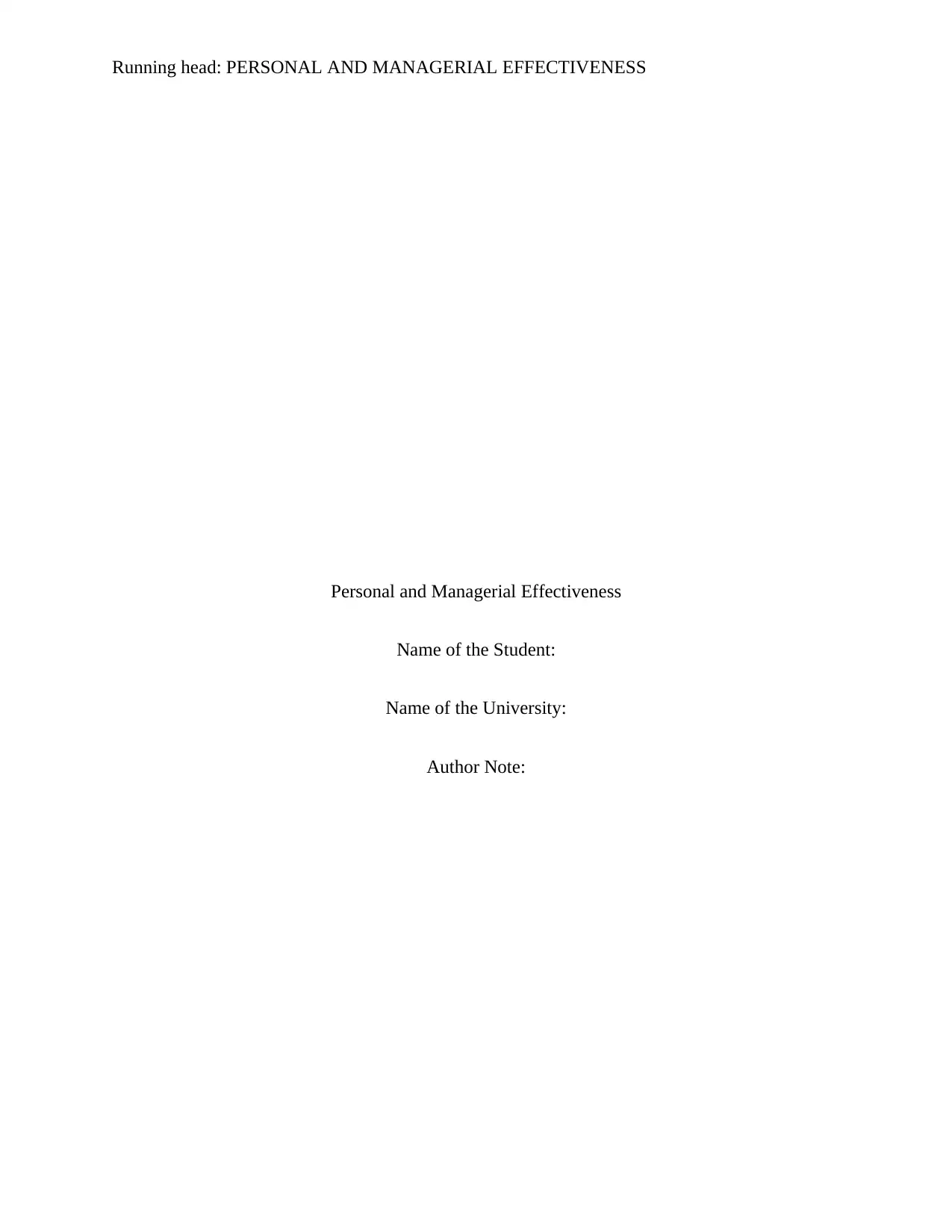
Running head: PERSONAL AND MANAGERIAL EFFECTIVENESS
Personal and Managerial Effectiveness
Name of the Student:
Name of the University:
Author Note:
Personal and Managerial Effectiveness
Name of the Student:
Name of the University:
Author Note:
Paraphrase This Document
Need a fresh take? Get an instant paraphrase of this document with our AI Paraphraser
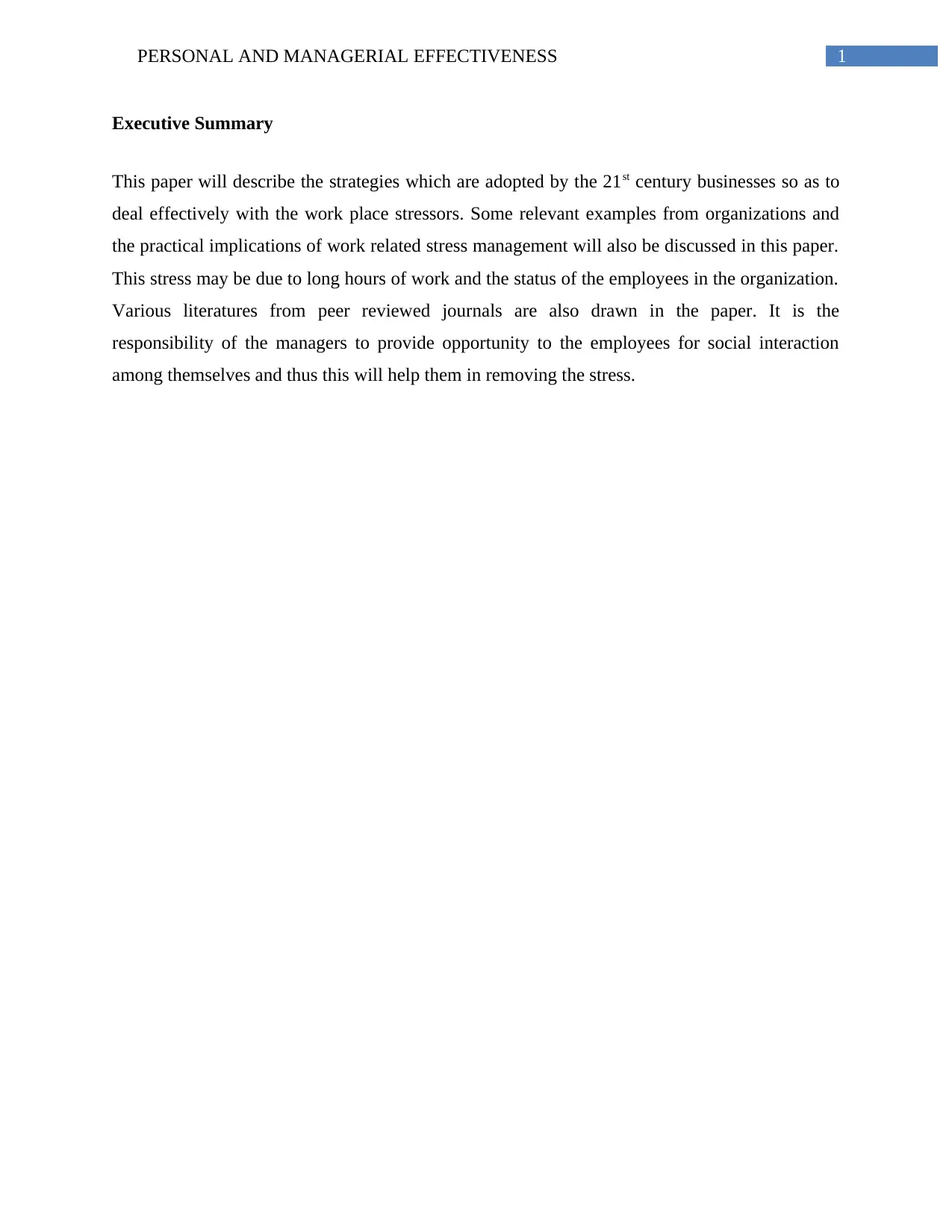
1PERSONAL AND MANAGERIAL EFFECTIVENESS
Executive Summary
This paper will describe the strategies which are adopted by the 21st century businesses so as to
deal effectively with the work place stressors. Some relevant examples from organizations and
the practical implications of work related stress management will also be discussed in this paper.
This stress may be due to long hours of work and the status of the employees in the organization.
Various literatures from peer reviewed journals are also drawn in the paper. It is the
responsibility of the managers to provide opportunity to the employees for social interaction
among themselves and thus this will help them in removing the stress.
Executive Summary
This paper will describe the strategies which are adopted by the 21st century businesses so as to
deal effectively with the work place stressors. Some relevant examples from organizations and
the practical implications of work related stress management will also be discussed in this paper.
This stress may be due to long hours of work and the status of the employees in the organization.
Various literatures from peer reviewed journals are also drawn in the paper. It is the
responsibility of the managers to provide opportunity to the employees for social interaction
among themselves and thus this will help them in removing the stress.
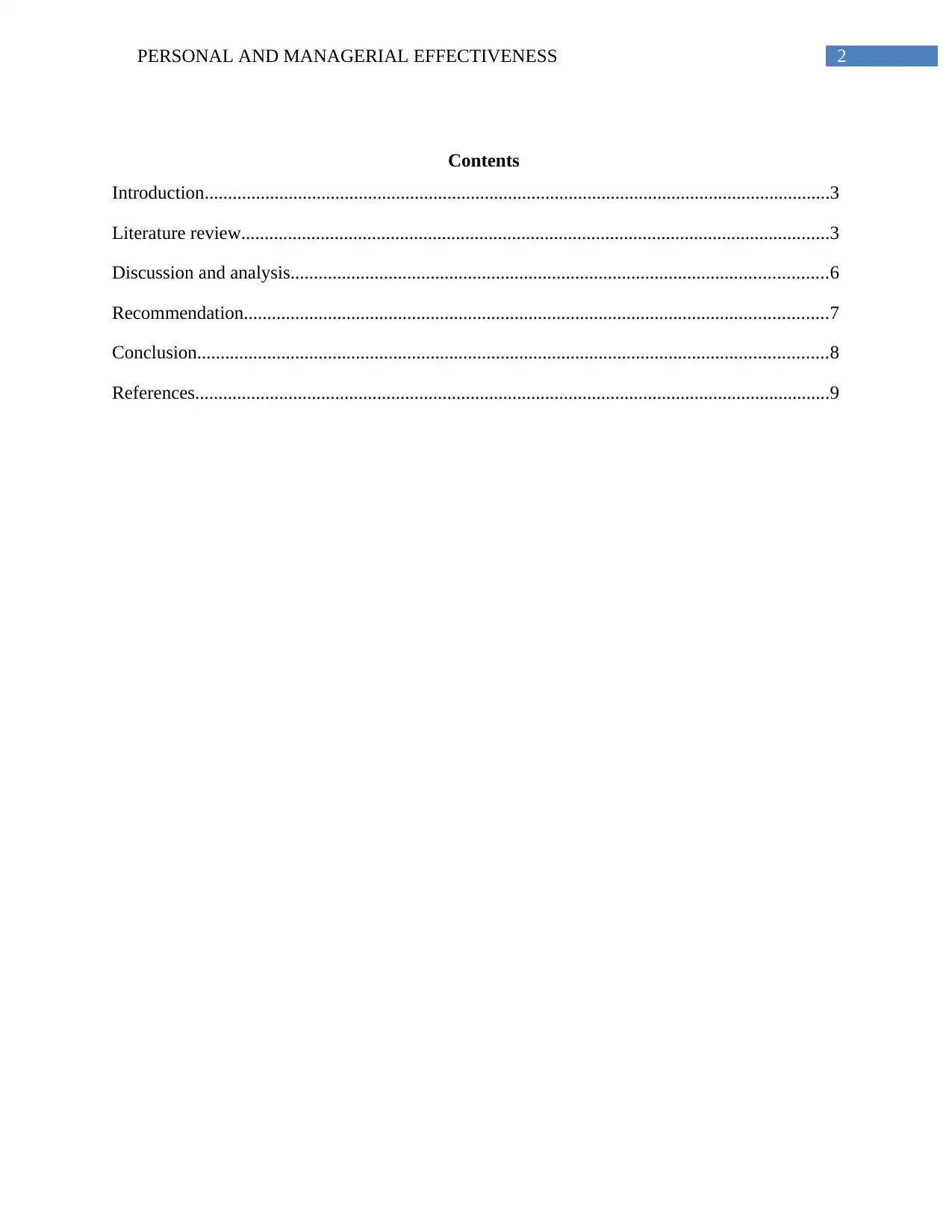
2PERSONAL AND MANAGERIAL EFFECTIVENESS
Contents
Introduction......................................................................................................................................3
Literature review..............................................................................................................................3
Discussion and analysis...................................................................................................................6
Recommendation.............................................................................................................................7
Conclusion.......................................................................................................................................8
References........................................................................................................................................9
Contents
Introduction......................................................................................................................................3
Literature review..............................................................................................................................3
Discussion and analysis...................................................................................................................6
Recommendation.............................................................................................................................7
Conclusion.......................................................................................................................................8
References........................................................................................................................................9
⊘ This is a preview!⊘
Do you want full access?
Subscribe today to unlock all pages.

Trusted by 1+ million students worldwide
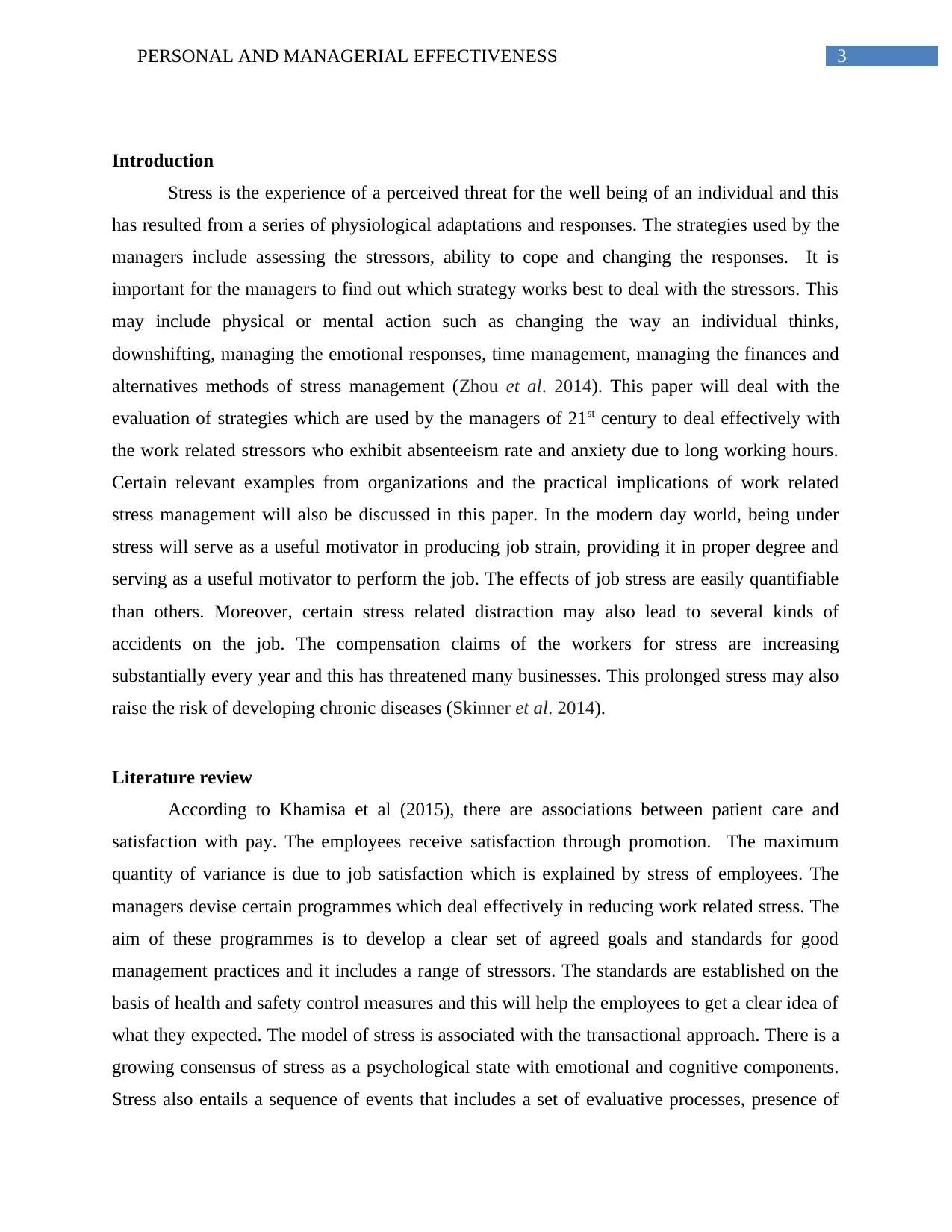
3PERSONAL AND MANAGERIAL EFFECTIVENESS
Introduction
Stress is the experience of a perceived threat for the well being of an individual and this
has resulted from a series of physiological adaptations and responses. The strategies used by the
managers include assessing the stressors, ability to cope and changing the responses. It is
important for the managers to find out which strategy works best to deal with the stressors. This
may include physical or mental action such as changing the way an individual thinks,
downshifting, managing the emotional responses, time management, managing the finances and
alternatives methods of stress management (Zhou et al. 2014). This paper will deal with the
evaluation of strategies which are used by the managers of 21st century to deal effectively with
the work related stressors who exhibit absenteeism rate and anxiety due to long working hours.
Certain relevant examples from organizations and the practical implications of work related
stress management will also be discussed in this paper. In the modern day world, being under
stress will serve as a useful motivator in producing job strain, providing it in proper degree and
serving as a useful motivator to perform the job. The effects of job stress are easily quantifiable
than others. Moreover, certain stress related distraction may also lead to several kinds of
accidents on the job. The compensation claims of the workers for stress are increasing
substantially every year and this has threatened many businesses. This prolonged stress may also
raise the risk of developing chronic diseases (Skinner et al. 2014).
Literature review
According to Khamisa et al (2015), there are associations between patient care and
satisfaction with pay. The employees receive satisfaction through promotion. The maximum
quantity of variance is due to job satisfaction which is explained by stress of employees. The
managers devise certain programmes which deal effectively in reducing work related stress. The
aim of these programmes is to develop a clear set of agreed goals and standards for good
management practices and it includes a range of stressors. The standards are established on the
basis of health and safety control measures and this will help the employees to get a clear idea of
what they expected. The model of stress is associated with the transactional approach. There is a
growing consensus of stress as a psychological state with emotional and cognitive components.
Stress also entails a sequence of events that includes a set of evaluative processes, presence of
Introduction
Stress is the experience of a perceived threat for the well being of an individual and this
has resulted from a series of physiological adaptations and responses. The strategies used by the
managers include assessing the stressors, ability to cope and changing the responses. It is
important for the managers to find out which strategy works best to deal with the stressors. This
may include physical or mental action such as changing the way an individual thinks,
downshifting, managing the emotional responses, time management, managing the finances and
alternatives methods of stress management (Zhou et al. 2014). This paper will deal with the
evaluation of strategies which are used by the managers of 21st century to deal effectively with
the work related stressors who exhibit absenteeism rate and anxiety due to long working hours.
Certain relevant examples from organizations and the practical implications of work related
stress management will also be discussed in this paper. In the modern day world, being under
stress will serve as a useful motivator in producing job strain, providing it in proper degree and
serving as a useful motivator to perform the job. The effects of job stress are easily quantifiable
than others. Moreover, certain stress related distraction may also lead to several kinds of
accidents on the job. The compensation claims of the workers for stress are increasing
substantially every year and this has threatened many businesses. This prolonged stress may also
raise the risk of developing chronic diseases (Skinner et al. 2014).
Literature review
According to Khamisa et al (2015), there are associations between patient care and
satisfaction with pay. The employees receive satisfaction through promotion. The maximum
quantity of variance is due to job satisfaction which is explained by stress of employees. The
managers devise certain programmes which deal effectively in reducing work related stress. The
aim of these programmes is to develop a clear set of agreed goals and standards for good
management practices and it includes a range of stressors. The standards are established on the
basis of health and safety control measures and this will help the employees to get a clear idea of
what they expected. The model of stress is associated with the transactional approach. There is a
growing consensus of stress as a psychological state with emotional and cognitive components.
Stress also entails a sequence of events that includes a set of evaluative processes, presence of
Paraphrase This Document
Need a fresh take? Get an instant paraphrase of this document with our AI Paraphraser
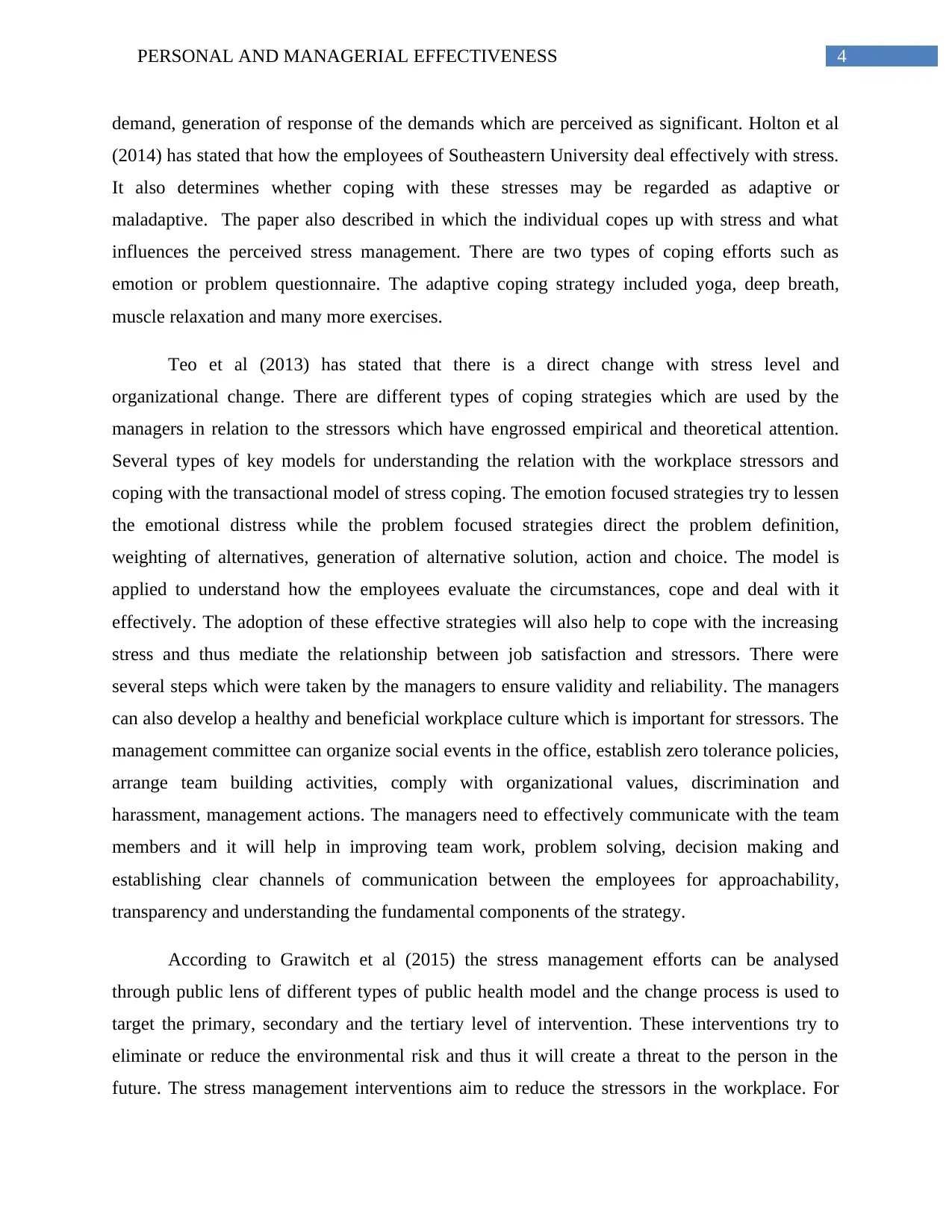
4PERSONAL AND MANAGERIAL EFFECTIVENESS
demand, generation of response of the demands which are perceived as significant. Holton et al
(2014) has stated that how the employees of Southeastern University deal effectively with stress.
It also determines whether coping with these stresses may be regarded as adaptive or
maladaptive. The paper also described in which the individual copes up with stress and what
influences the perceived stress management. There are two types of coping efforts such as
emotion or problem questionnaire. The adaptive coping strategy included yoga, deep breath,
muscle relaxation and many more exercises.
Teo et al (2013) has stated that there is a direct change with stress level and
organizational change. There are different types of coping strategies which are used by the
managers in relation to the stressors which have engrossed empirical and theoretical attention.
Several types of key models for understanding the relation with the workplace stressors and
coping with the transactional model of stress coping. The emotion focused strategies try to lessen
the emotional distress while the problem focused strategies direct the problem definition,
weighting of alternatives, generation of alternative solution, action and choice. The model is
applied to understand how the employees evaluate the circumstances, cope and deal with it
effectively. The adoption of these effective strategies will also help to cope with the increasing
stress and thus mediate the relationship between job satisfaction and stressors. There were
several steps which were taken by the managers to ensure validity and reliability. The managers
can also develop a healthy and beneficial workplace culture which is important for stressors. The
management committee can organize social events in the office, establish zero tolerance policies,
arrange team building activities, comply with organizational values, discrimination and
harassment, management actions. The managers need to effectively communicate with the team
members and it will help in improving team work, problem solving, decision making and
establishing clear channels of communication between the employees for approachability,
transparency and understanding the fundamental components of the strategy.
According to Grawitch et al (2015) the stress management efforts can be analysed
through public lens of different types of public health model and the change process is used to
target the primary, secondary and the tertiary level of intervention. These interventions try to
eliminate or reduce the environmental risk and thus it will create a threat to the person in the
future. The stress management interventions aim to reduce the stressors in the workplace. For
demand, generation of response of the demands which are perceived as significant. Holton et al
(2014) has stated that how the employees of Southeastern University deal effectively with stress.
It also determines whether coping with these stresses may be regarded as adaptive or
maladaptive. The paper also described in which the individual copes up with stress and what
influences the perceived stress management. There are two types of coping efforts such as
emotion or problem questionnaire. The adaptive coping strategy included yoga, deep breath,
muscle relaxation and many more exercises.
Teo et al (2013) has stated that there is a direct change with stress level and
organizational change. There are different types of coping strategies which are used by the
managers in relation to the stressors which have engrossed empirical and theoretical attention.
Several types of key models for understanding the relation with the workplace stressors and
coping with the transactional model of stress coping. The emotion focused strategies try to lessen
the emotional distress while the problem focused strategies direct the problem definition,
weighting of alternatives, generation of alternative solution, action and choice. The model is
applied to understand how the employees evaluate the circumstances, cope and deal with it
effectively. The adoption of these effective strategies will also help to cope with the increasing
stress and thus mediate the relationship between job satisfaction and stressors. There were
several steps which were taken by the managers to ensure validity and reliability. The managers
can also develop a healthy and beneficial workplace culture which is important for stressors. The
management committee can organize social events in the office, establish zero tolerance policies,
arrange team building activities, comply with organizational values, discrimination and
harassment, management actions. The managers need to effectively communicate with the team
members and it will help in improving team work, problem solving, decision making and
establishing clear channels of communication between the employees for approachability,
transparency and understanding the fundamental components of the strategy.
According to Grawitch et al (2015) the stress management efforts can be analysed
through public lens of different types of public health model and the change process is used to
target the primary, secondary and the tertiary level of intervention. These interventions try to
eliminate or reduce the environmental risk and thus it will create a threat to the person in the
future. The stress management interventions aim to reduce the stressors in the workplace. For
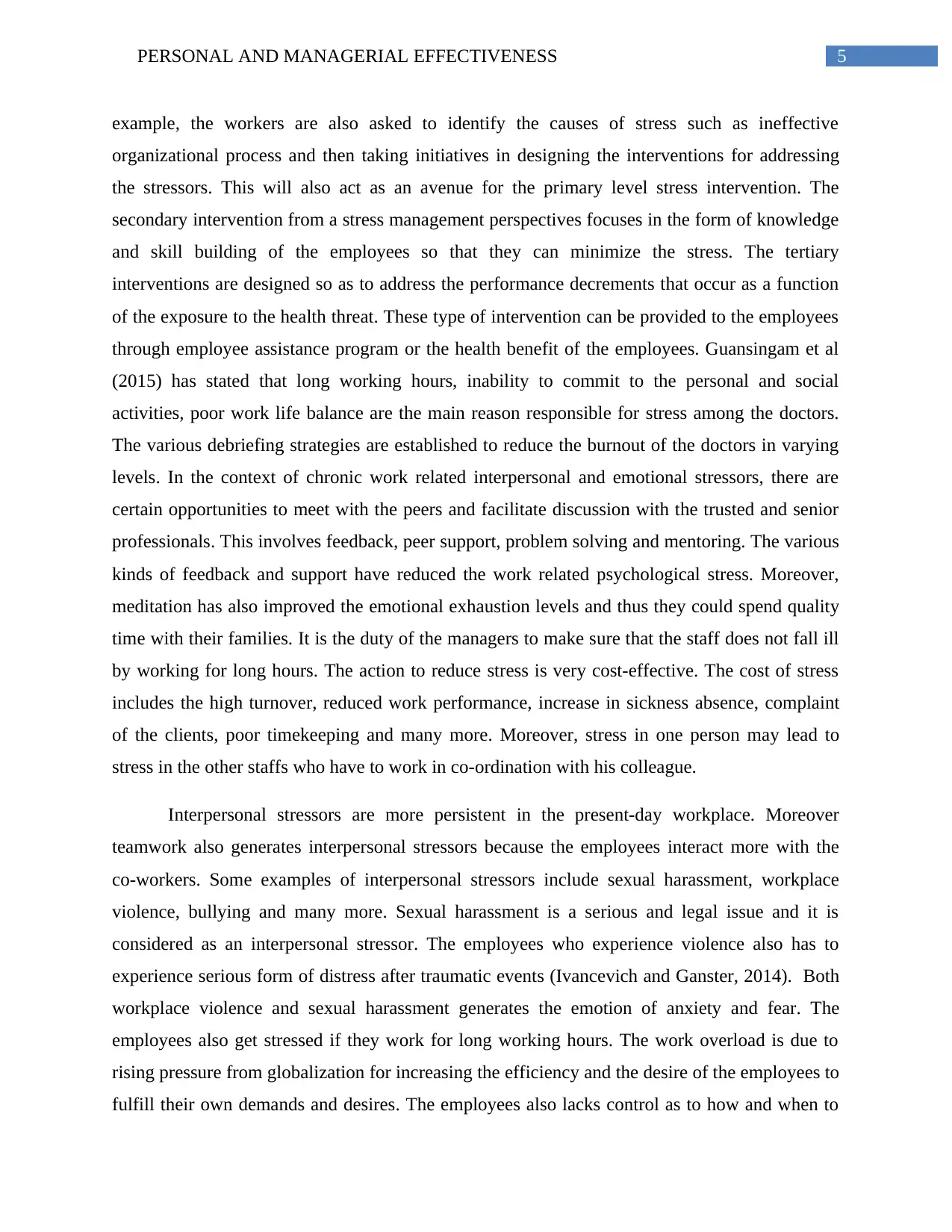
5PERSONAL AND MANAGERIAL EFFECTIVENESS
example, the workers are also asked to identify the causes of stress such as ineffective
organizational process and then taking initiatives in designing the interventions for addressing
the stressors. This will also act as an avenue for the primary level stress intervention. The
secondary intervention from a stress management perspectives focuses in the form of knowledge
and skill building of the employees so that they can minimize the stress. The tertiary
interventions are designed so as to address the performance decrements that occur as a function
of the exposure to the health threat. These type of intervention can be provided to the employees
through employee assistance program or the health benefit of the employees. Guansingam et al
(2015) has stated that long working hours, inability to commit to the personal and social
activities, poor work life balance are the main reason responsible for stress among the doctors.
The various debriefing strategies are established to reduce the burnout of the doctors in varying
levels. In the context of chronic work related interpersonal and emotional stressors, there are
certain opportunities to meet with the peers and facilitate discussion with the trusted and senior
professionals. This involves feedback, peer support, problem solving and mentoring. The various
kinds of feedback and support have reduced the work related psychological stress. Moreover,
meditation has also improved the emotional exhaustion levels and thus they could spend quality
time with their families. It is the duty of the managers to make sure that the staff does not fall ill
by working for long hours. The action to reduce stress is very cost-effective. The cost of stress
includes the high turnover, reduced work performance, increase in sickness absence, complaint
of the clients, poor timekeeping and many more. Moreover, stress in one person may lead to
stress in the other staffs who have to work in co-ordination with his colleague.
Interpersonal stressors are more persistent in the present-day workplace. Moreover
teamwork also generates interpersonal stressors because the employees interact more with the
co-workers. Some examples of interpersonal stressors include sexual harassment, workplace
violence, bullying and many more. Sexual harassment is a serious and legal issue and it is
considered as an interpersonal stressor. The employees who experience violence also has to
experience serious form of distress after traumatic events (Ivancevich and Ganster, 2014). Both
workplace violence and sexual harassment generates the emotion of anxiety and fear. The
employees also get stressed if they work for long working hours. The work overload is due to
rising pressure from globalization for increasing the efficiency and the desire of the employees to
fulfill their own demands and desires. The employees also lacks control as to how and when to
example, the workers are also asked to identify the causes of stress such as ineffective
organizational process and then taking initiatives in designing the interventions for addressing
the stressors. This will also act as an avenue for the primary level stress intervention. The
secondary intervention from a stress management perspectives focuses in the form of knowledge
and skill building of the employees so that they can minimize the stress. The tertiary
interventions are designed so as to address the performance decrements that occur as a function
of the exposure to the health threat. These type of intervention can be provided to the employees
through employee assistance program or the health benefit of the employees. Guansingam et al
(2015) has stated that long working hours, inability to commit to the personal and social
activities, poor work life balance are the main reason responsible for stress among the doctors.
The various debriefing strategies are established to reduce the burnout of the doctors in varying
levels. In the context of chronic work related interpersonal and emotional stressors, there are
certain opportunities to meet with the peers and facilitate discussion with the trusted and senior
professionals. This involves feedback, peer support, problem solving and mentoring. The various
kinds of feedback and support have reduced the work related psychological stress. Moreover,
meditation has also improved the emotional exhaustion levels and thus they could spend quality
time with their families. It is the duty of the managers to make sure that the staff does not fall ill
by working for long hours. The action to reduce stress is very cost-effective. The cost of stress
includes the high turnover, reduced work performance, increase in sickness absence, complaint
of the clients, poor timekeeping and many more. Moreover, stress in one person may lead to
stress in the other staffs who have to work in co-ordination with his colleague.
Interpersonal stressors are more persistent in the present-day workplace. Moreover
teamwork also generates interpersonal stressors because the employees interact more with the
co-workers. Some examples of interpersonal stressors include sexual harassment, workplace
violence, bullying and many more. Sexual harassment is a serious and legal issue and it is
considered as an interpersonal stressor. The employees who experience violence also has to
experience serious form of distress after traumatic events (Ivancevich and Ganster, 2014). Both
workplace violence and sexual harassment generates the emotion of anxiety and fear. The
employees also get stressed if they work for long working hours. The work overload is due to
rising pressure from globalization for increasing the efficiency and the desire of the employees to
fulfill their own demands and desires. The employees also lacks control as to how and when to
⊘ This is a preview!⊘
Do you want full access?
Subscribe today to unlock all pages.

Trusted by 1+ million students worldwide
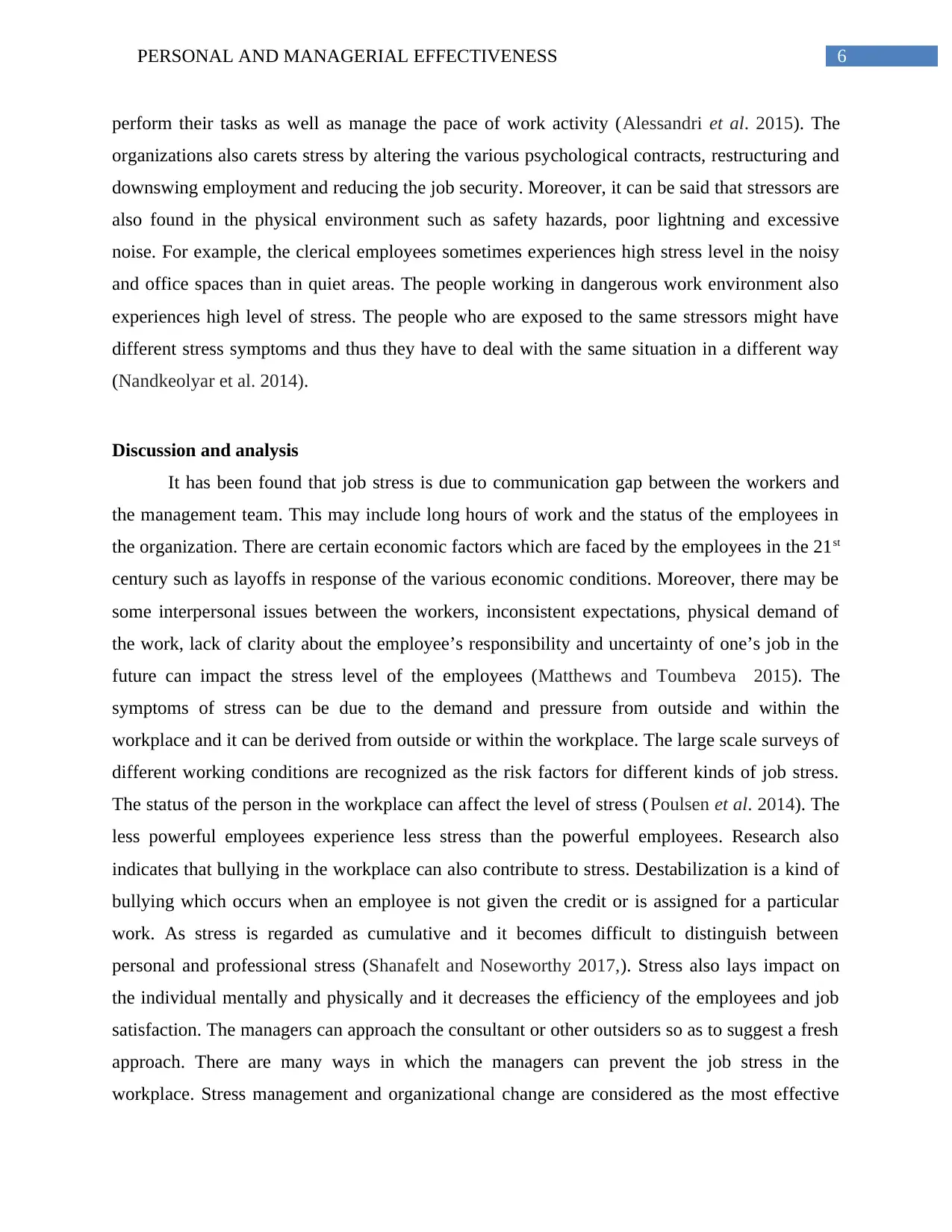
6PERSONAL AND MANAGERIAL EFFECTIVENESS
perform their tasks as well as manage the pace of work activity (Alessandri et al. 2015). The
organizations also carets stress by altering the various psychological contracts, restructuring and
downswing employment and reducing the job security. Moreover, it can be said that stressors are
also found in the physical environment such as safety hazards, poor lightning and excessive
noise. For example, the clerical employees sometimes experiences high stress level in the noisy
and office spaces than in quiet areas. The people working in dangerous work environment also
experiences high level of stress. The people who are exposed to the same stressors might have
different stress symptoms and thus they have to deal with the same situation in a different way
(Nandkeolyar et al. 2014).
Discussion and analysis
It has been found that job stress is due to communication gap between the workers and
the management team. This may include long hours of work and the status of the employees in
the organization. There are certain economic factors which are faced by the employees in the 21st
century such as layoffs in response of the various economic conditions. Moreover, there may be
some interpersonal issues between the workers, inconsistent expectations, physical demand of
the work, lack of clarity about the employee’s responsibility and uncertainty of one’s job in the
future can impact the stress level of the employees (Matthews and Toumbeva 2015). The
symptoms of stress can be due to the demand and pressure from outside and within the
workplace and it can be derived from outside or within the workplace. The large scale surveys of
different working conditions are recognized as the risk factors for different kinds of job stress.
The status of the person in the workplace can affect the level of stress (Poulsen et al. 2014). The
less powerful employees experience less stress than the powerful employees. Research also
indicates that bullying in the workplace can also contribute to stress. Destabilization is a kind of
bullying which occurs when an employee is not given the credit or is assigned for a particular
work. As stress is regarded as cumulative and it becomes difficult to distinguish between
personal and professional stress (Shanafelt and Noseworthy 2017,). Stress also lays impact on
the individual mentally and physically and it decreases the efficiency of the employees and job
satisfaction. The managers can approach the consultant or other outsiders so as to suggest a fresh
approach. There are many ways in which the managers can prevent the job stress in the
workplace. Stress management and organizational change are considered as the most effective
perform their tasks as well as manage the pace of work activity (Alessandri et al. 2015). The
organizations also carets stress by altering the various psychological contracts, restructuring and
downswing employment and reducing the job security. Moreover, it can be said that stressors are
also found in the physical environment such as safety hazards, poor lightning and excessive
noise. For example, the clerical employees sometimes experiences high stress level in the noisy
and office spaces than in quiet areas. The people working in dangerous work environment also
experiences high level of stress. The people who are exposed to the same stressors might have
different stress symptoms and thus they have to deal with the same situation in a different way
(Nandkeolyar et al. 2014).
Discussion and analysis
It has been found that job stress is due to communication gap between the workers and
the management team. This may include long hours of work and the status of the employees in
the organization. There are certain economic factors which are faced by the employees in the 21st
century such as layoffs in response of the various economic conditions. Moreover, there may be
some interpersonal issues between the workers, inconsistent expectations, physical demand of
the work, lack of clarity about the employee’s responsibility and uncertainty of one’s job in the
future can impact the stress level of the employees (Matthews and Toumbeva 2015). The
symptoms of stress can be due to the demand and pressure from outside and within the
workplace and it can be derived from outside or within the workplace. The large scale surveys of
different working conditions are recognized as the risk factors for different kinds of job stress.
The status of the person in the workplace can affect the level of stress (Poulsen et al. 2014). The
less powerful employees experience less stress than the powerful employees. Research also
indicates that bullying in the workplace can also contribute to stress. Destabilization is a kind of
bullying which occurs when an employee is not given the credit or is assigned for a particular
work. As stress is regarded as cumulative and it becomes difficult to distinguish between
personal and professional stress (Shanafelt and Noseworthy 2017,). Stress also lays impact on
the individual mentally and physically and it decreases the efficiency of the employees and job
satisfaction. The managers can approach the consultant or other outsiders so as to suggest a fresh
approach. There are many ways in which the managers can prevent the job stress in the
workplace. Stress management and organizational change are considered as the most effective
Paraphrase This Document
Need a fresh take? Get an instant paraphrase of this document with our AI Paraphraser
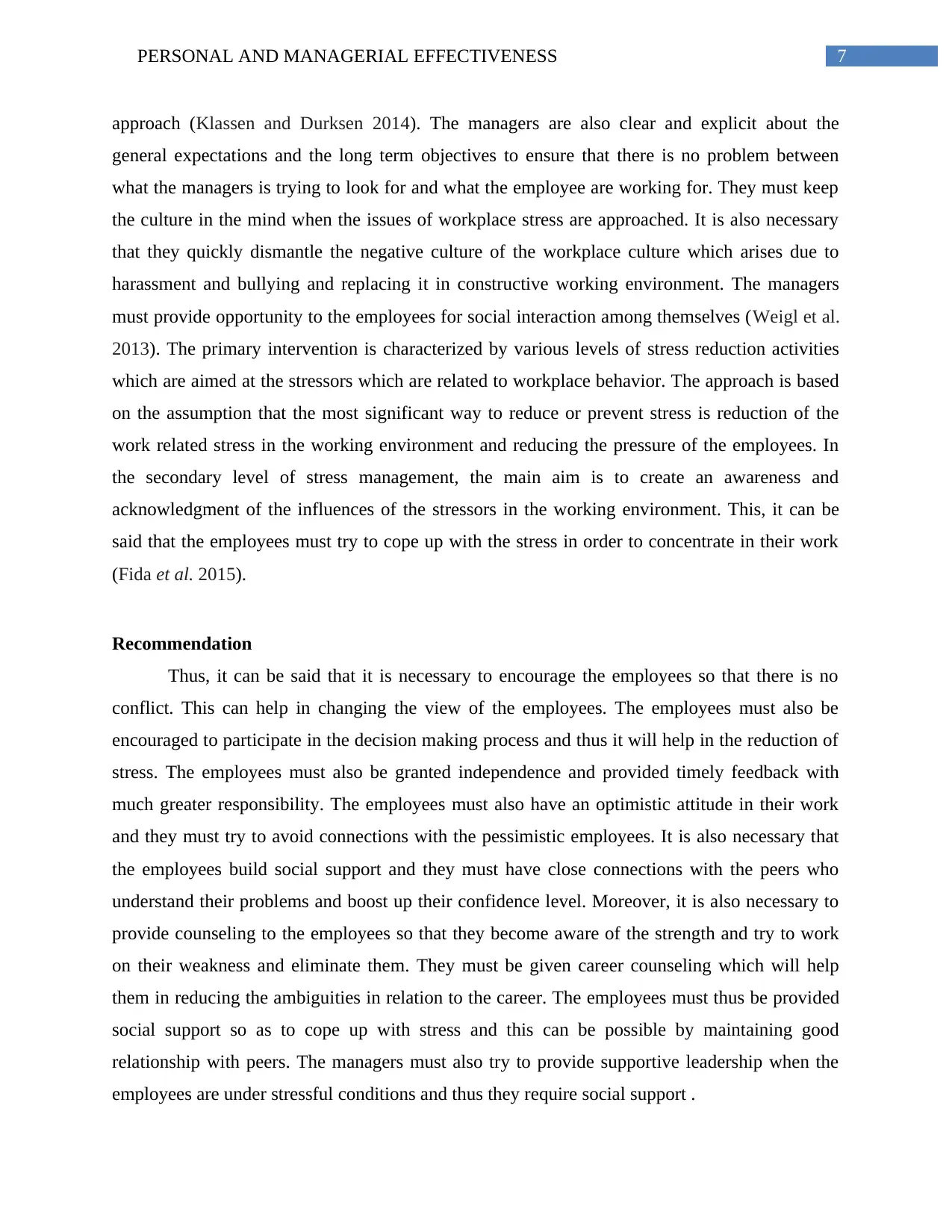
7PERSONAL AND MANAGERIAL EFFECTIVENESS
approach (Klassen and Durksen 2014). The managers are also clear and explicit about the
general expectations and the long term objectives to ensure that there is no problem between
what the managers is trying to look for and what the employee are working for. They must keep
the culture in the mind when the issues of workplace stress are approached. It is also necessary
that they quickly dismantle the negative culture of the workplace culture which arises due to
harassment and bullying and replacing it in constructive working environment. The managers
must provide opportunity to the employees for social interaction among themselves (Weigl et al.
2013). The primary intervention is characterized by various levels of stress reduction activities
which are aimed at the stressors which are related to workplace behavior. The approach is based
on the assumption that the most significant way to reduce or prevent stress is reduction of the
work related stress in the working environment and reducing the pressure of the employees. In
the secondary level of stress management, the main aim is to create an awareness and
acknowledgment of the influences of the stressors in the working environment. This, it can be
said that the employees must try to cope up with the stress in order to concentrate in their work
(Fida et al. 2015).
Recommendation
Thus, it can be said that it is necessary to encourage the employees so that there is no
conflict. This can help in changing the view of the employees. The employees must also be
encouraged to participate in the decision making process and thus it will help in the reduction of
stress. The employees must also be granted independence and provided timely feedback with
much greater responsibility. The employees must also have an optimistic attitude in their work
and they must try to avoid connections with the pessimistic employees. It is also necessary that
the employees build social support and they must have close connections with the peers who
understand their problems and boost up their confidence level. Moreover, it is also necessary to
provide counseling to the employees so that they become aware of the strength and try to work
on their weakness and eliminate them. They must be given career counseling which will help
them in reducing the ambiguities in relation to the career. The employees must thus be provided
social support so as to cope up with stress and this can be possible by maintaining good
relationship with peers. The managers must also try to provide supportive leadership when the
employees are under stressful conditions and thus they require social support .
approach (Klassen and Durksen 2014). The managers are also clear and explicit about the
general expectations and the long term objectives to ensure that there is no problem between
what the managers is trying to look for and what the employee are working for. They must keep
the culture in the mind when the issues of workplace stress are approached. It is also necessary
that they quickly dismantle the negative culture of the workplace culture which arises due to
harassment and bullying and replacing it in constructive working environment. The managers
must provide opportunity to the employees for social interaction among themselves (Weigl et al.
2013). The primary intervention is characterized by various levels of stress reduction activities
which are aimed at the stressors which are related to workplace behavior. The approach is based
on the assumption that the most significant way to reduce or prevent stress is reduction of the
work related stress in the working environment and reducing the pressure of the employees. In
the secondary level of stress management, the main aim is to create an awareness and
acknowledgment of the influences of the stressors in the working environment. This, it can be
said that the employees must try to cope up with the stress in order to concentrate in their work
(Fida et al. 2015).
Recommendation
Thus, it can be said that it is necessary to encourage the employees so that there is no
conflict. This can help in changing the view of the employees. The employees must also be
encouraged to participate in the decision making process and thus it will help in the reduction of
stress. The employees must also be granted independence and provided timely feedback with
much greater responsibility. The employees must also have an optimistic attitude in their work
and they must try to avoid connections with the pessimistic employees. It is also necessary that
the employees build social support and they must have close connections with the peers who
understand their problems and boost up their confidence level. Moreover, it is also necessary to
provide counseling to the employees so that they become aware of the strength and try to work
on their weakness and eliminate them. They must be given career counseling which will help
them in reducing the ambiguities in relation to the career. The employees must thus be provided
social support so as to cope up with stress and this can be possible by maintaining good
relationship with peers. The managers must also try to provide supportive leadership when the
employees are under stressful conditions and thus they require social support .
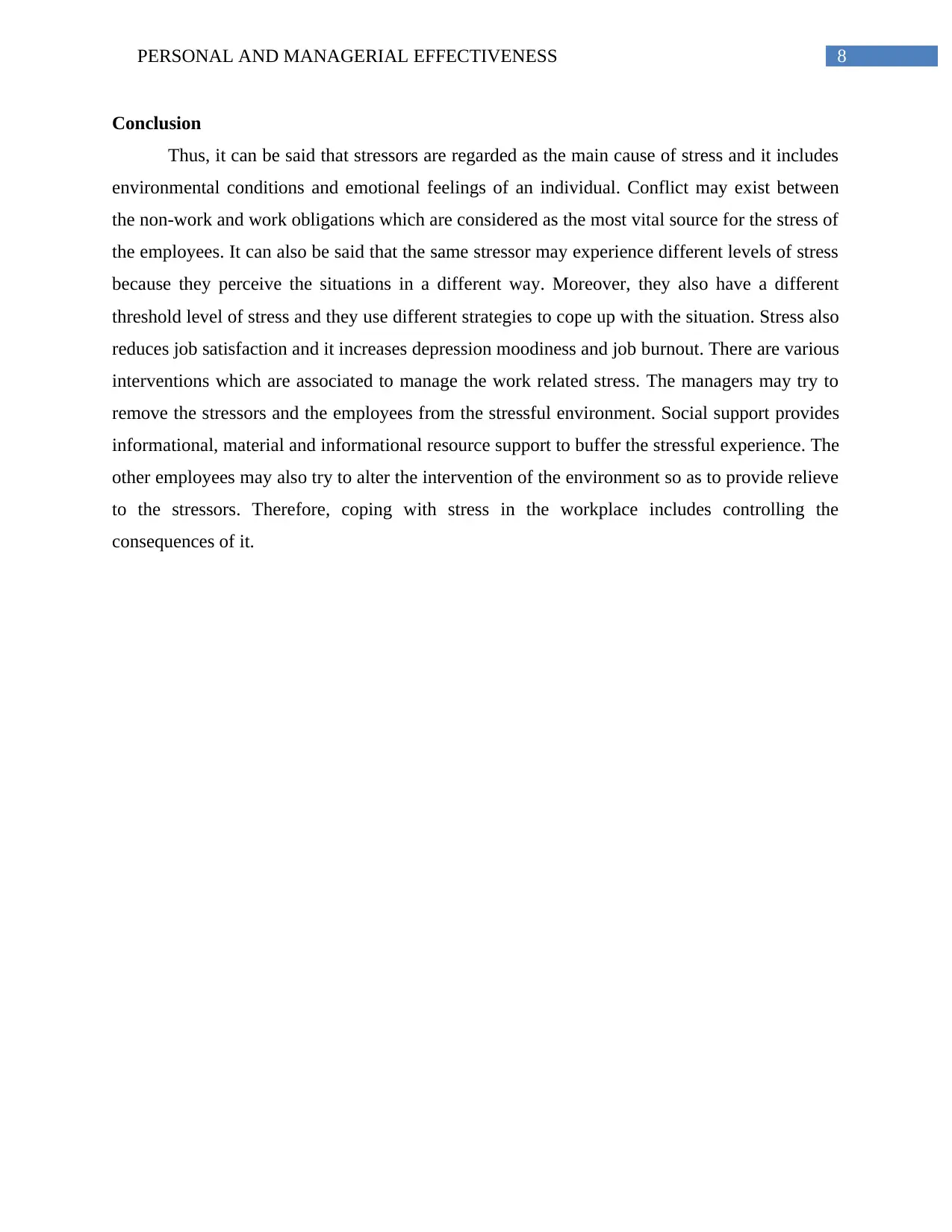
8PERSONAL AND MANAGERIAL EFFECTIVENESS
Conclusion
Thus, it can be said that stressors are regarded as the main cause of stress and it includes
environmental conditions and emotional feelings of an individual. Conflict may exist between
the non-work and work obligations which are considered as the most vital source for the stress of
the employees. It can also be said that the same stressor may experience different levels of stress
because they perceive the situations in a different way. Moreover, they also have a different
threshold level of stress and they use different strategies to cope up with the situation. Stress also
reduces job satisfaction and it increases depression moodiness and job burnout. There are various
interventions which are associated to manage the work related stress. The managers may try to
remove the stressors and the employees from the stressful environment. Social support provides
informational, material and informational resource support to buffer the stressful experience. The
other employees may also try to alter the intervention of the environment so as to provide relieve
to the stressors. Therefore, coping with stress in the workplace includes controlling the
consequences of it.
Conclusion
Thus, it can be said that stressors are regarded as the main cause of stress and it includes
environmental conditions and emotional feelings of an individual. Conflict may exist between
the non-work and work obligations which are considered as the most vital source for the stress of
the employees. It can also be said that the same stressor may experience different levels of stress
because they perceive the situations in a different way. Moreover, they also have a different
threshold level of stress and they use different strategies to cope up with the situation. Stress also
reduces job satisfaction and it increases depression moodiness and job burnout. There are various
interventions which are associated to manage the work related stress. The managers may try to
remove the stressors and the employees from the stressful environment. Social support provides
informational, material and informational resource support to buffer the stressful experience. The
other employees may also try to alter the intervention of the environment so as to provide relieve
to the stressors. Therefore, coping with stress in the workplace includes controlling the
consequences of it.
⊘ This is a preview!⊘
Do you want full access?
Subscribe today to unlock all pages.

Trusted by 1+ million students worldwide
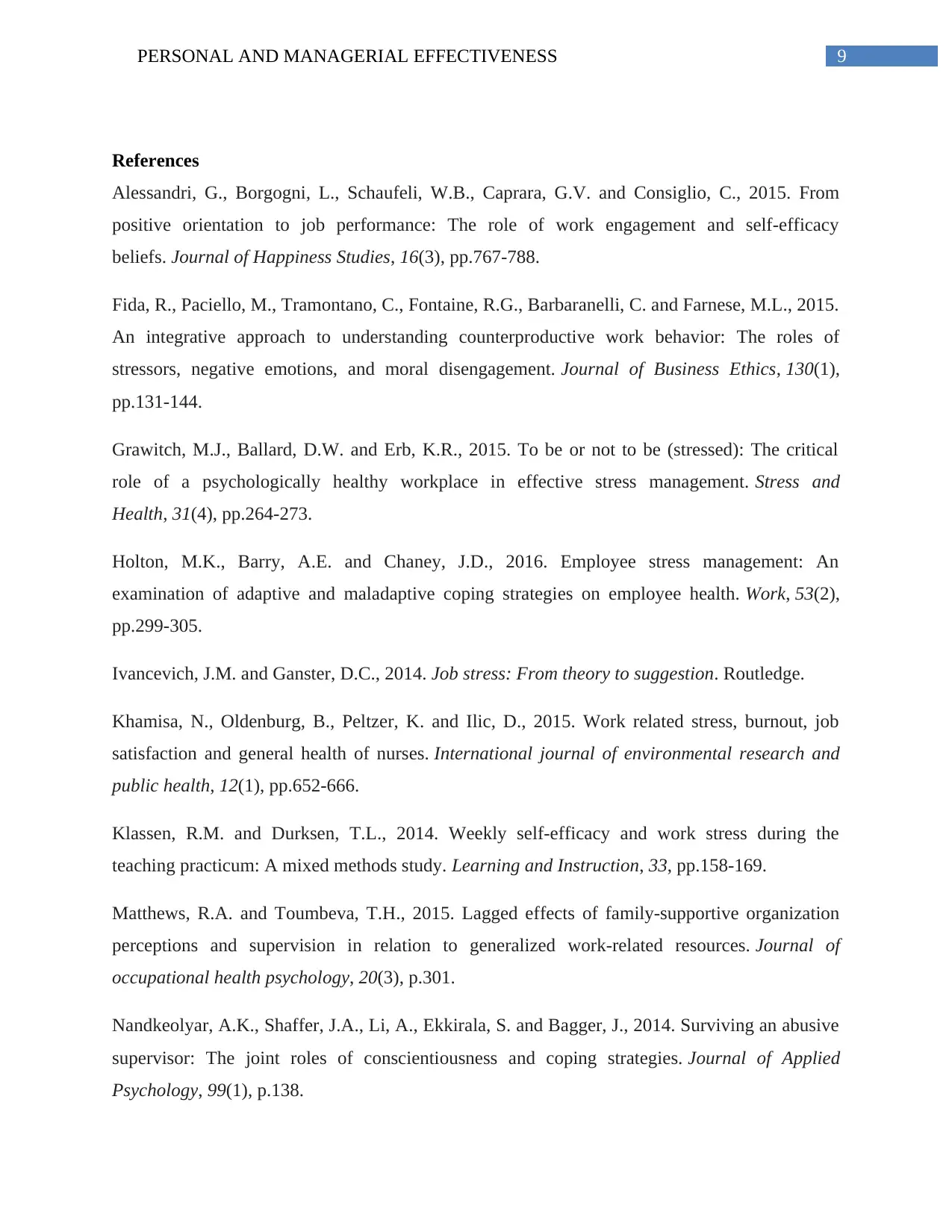
9PERSONAL AND MANAGERIAL EFFECTIVENESS
References
Alessandri, G., Borgogni, L., Schaufeli, W.B., Caprara, G.V. and Consiglio, C., 2015. From
positive orientation to job performance: The role of work engagement and self-efficacy
beliefs. Journal of Happiness Studies, 16(3), pp.767-788.
Fida, R., Paciello, M., Tramontano, C., Fontaine, R.G., Barbaranelli, C. and Farnese, M.L., 2015.
An integrative approach to understanding counterproductive work behavior: The roles of
stressors, negative emotions, and moral disengagement. Journal of Business Ethics, 130(1),
pp.131-144.
Grawitch, M.J., Ballard, D.W. and Erb, K.R., 2015. To be or not to be (stressed): The critical
role of a psychologically healthy workplace in effective stress management. Stress and
Health, 31(4), pp.264-273.
Holton, M.K., Barry, A.E. and Chaney, J.D., 2016. Employee stress management: An
examination of adaptive and maladaptive coping strategies on employee health. Work, 53(2),
pp.299-305.
Ivancevich, J.M. and Ganster, D.C., 2014. Job stress: From theory to suggestion. Routledge.
Khamisa, N., Oldenburg, B., Peltzer, K. and Ilic, D., 2015. Work related stress, burnout, job
satisfaction and general health of nurses. International journal of environmental research and
public health, 12(1), pp.652-666.
Klassen, R.M. and Durksen, T.L., 2014. Weekly self-efficacy and work stress during the
teaching practicum: A mixed methods study. Learning and Instruction, 33, pp.158-169.
Matthews, R.A. and Toumbeva, T.H., 2015. Lagged effects of family-supportive organization
perceptions and supervision in relation to generalized work-related resources. Journal of
occupational health psychology, 20(3), p.301.
Nandkeolyar, A.K., Shaffer, J.A., Li, A., Ekkirala, S. and Bagger, J., 2014. Surviving an abusive
supervisor: The joint roles of conscientiousness and coping strategies. Journal of Applied
Psychology, 99(1), p.138.
References
Alessandri, G., Borgogni, L., Schaufeli, W.B., Caprara, G.V. and Consiglio, C., 2015. From
positive orientation to job performance: The role of work engagement and self-efficacy
beliefs. Journal of Happiness Studies, 16(3), pp.767-788.
Fida, R., Paciello, M., Tramontano, C., Fontaine, R.G., Barbaranelli, C. and Farnese, M.L., 2015.
An integrative approach to understanding counterproductive work behavior: The roles of
stressors, negative emotions, and moral disengagement. Journal of Business Ethics, 130(1),
pp.131-144.
Grawitch, M.J., Ballard, D.W. and Erb, K.R., 2015. To be or not to be (stressed): The critical
role of a psychologically healthy workplace in effective stress management. Stress and
Health, 31(4), pp.264-273.
Holton, M.K., Barry, A.E. and Chaney, J.D., 2016. Employee stress management: An
examination of adaptive and maladaptive coping strategies on employee health. Work, 53(2),
pp.299-305.
Ivancevich, J.M. and Ganster, D.C., 2014. Job stress: From theory to suggestion. Routledge.
Khamisa, N., Oldenburg, B., Peltzer, K. and Ilic, D., 2015. Work related stress, burnout, job
satisfaction and general health of nurses. International journal of environmental research and
public health, 12(1), pp.652-666.
Klassen, R.M. and Durksen, T.L., 2014. Weekly self-efficacy and work stress during the
teaching practicum: A mixed methods study. Learning and Instruction, 33, pp.158-169.
Matthews, R.A. and Toumbeva, T.H., 2015. Lagged effects of family-supportive organization
perceptions and supervision in relation to generalized work-related resources. Journal of
occupational health psychology, 20(3), p.301.
Nandkeolyar, A.K., Shaffer, J.A., Li, A., Ekkirala, S. and Bagger, J., 2014. Surviving an abusive
supervisor: The joint roles of conscientiousness and coping strategies. Journal of Applied
Psychology, 99(1), p.138.
Paraphrase This Document
Need a fresh take? Get an instant paraphrase of this document with our AI Paraphraser
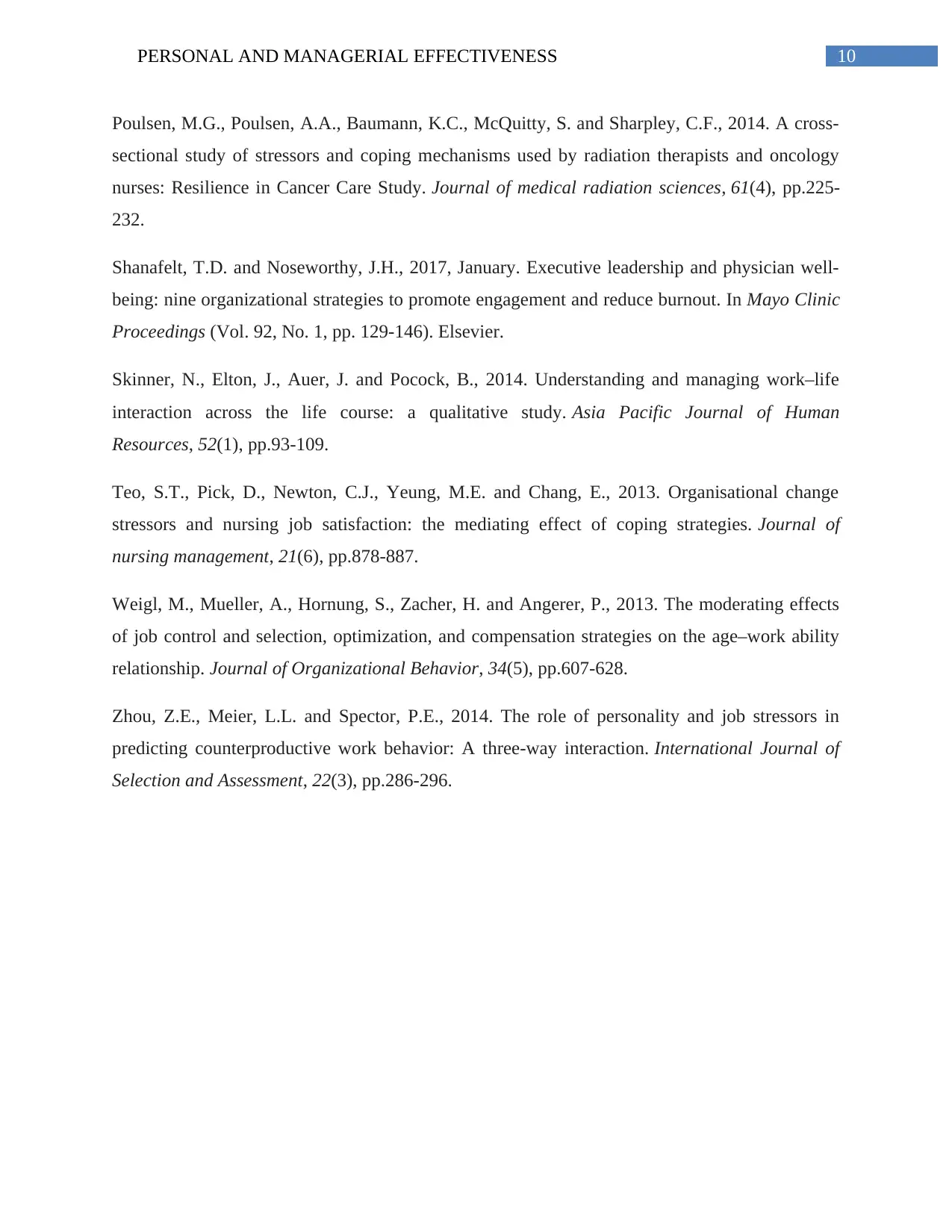
10PERSONAL AND MANAGERIAL EFFECTIVENESS
Poulsen, M.G., Poulsen, A.A., Baumann, K.C., McQuitty, S. and Sharpley, C.F., 2014. A cross‐
sectional study of stressors and coping mechanisms used by radiation therapists and oncology
nurses: Resilience in Cancer Care Study. Journal of medical radiation sciences, 61(4), pp.225-
232.
Shanafelt, T.D. and Noseworthy, J.H., 2017, January. Executive leadership and physician well-
being: nine organizational strategies to promote engagement and reduce burnout. In Mayo Clinic
Proceedings (Vol. 92, No. 1, pp. 129-146). Elsevier.
Skinner, N., Elton, J., Auer, J. and Pocock, B., 2014. Understanding and managing work–life
interaction across the life course: a qualitative study. Asia Pacific Journal of Human
Resources, 52(1), pp.93-109.
Teo, S.T., Pick, D., Newton, C.J., Yeung, M.E. and Chang, E., 2013. Organisational change
stressors and nursing job satisfaction: the mediating effect of coping strategies. Journal of
nursing management, 21(6), pp.878-887.
Weigl, M., Mueller, A., Hornung, S., Zacher, H. and Angerer, P., 2013. The moderating effects
of job control and selection, optimization, and compensation strategies on the age–work ability
relationship. Journal of Organizational Behavior, 34(5), pp.607-628.
Zhou, Z.E., Meier, L.L. and Spector, P.E., 2014. The role of personality and job stressors in
predicting counterproductive work behavior: A three‐way interaction. International Journal of
Selection and Assessment, 22(3), pp.286-296.
Poulsen, M.G., Poulsen, A.A., Baumann, K.C., McQuitty, S. and Sharpley, C.F., 2014. A cross‐
sectional study of stressors and coping mechanisms used by radiation therapists and oncology
nurses: Resilience in Cancer Care Study. Journal of medical radiation sciences, 61(4), pp.225-
232.
Shanafelt, T.D. and Noseworthy, J.H., 2017, January. Executive leadership and physician well-
being: nine organizational strategies to promote engagement and reduce burnout. In Mayo Clinic
Proceedings (Vol. 92, No. 1, pp. 129-146). Elsevier.
Skinner, N., Elton, J., Auer, J. and Pocock, B., 2014. Understanding and managing work–life
interaction across the life course: a qualitative study. Asia Pacific Journal of Human
Resources, 52(1), pp.93-109.
Teo, S.T., Pick, D., Newton, C.J., Yeung, M.E. and Chang, E., 2013. Organisational change
stressors and nursing job satisfaction: the mediating effect of coping strategies. Journal of
nursing management, 21(6), pp.878-887.
Weigl, M., Mueller, A., Hornung, S., Zacher, H. and Angerer, P., 2013. The moderating effects
of job control and selection, optimization, and compensation strategies on the age–work ability
relationship. Journal of Organizational Behavior, 34(5), pp.607-628.
Zhou, Z.E., Meier, L.L. and Spector, P.E., 2014. The role of personality and job stressors in
predicting counterproductive work behavior: A three‐way interaction. International Journal of
Selection and Assessment, 22(3), pp.286-296.
1 out of 11
Related Documents
Your All-in-One AI-Powered Toolkit for Academic Success.
+13062052269
info@desklib.com
Available 24*7 on WhatsApp / Email
![[object Object]](/_next/static/media/star-bottom.7253800d.svg)
Unlock your academic potential
Copyright © 2020–2025 A2Z Services. All Rights Reserved. Developed and managed by ZUCOL.





